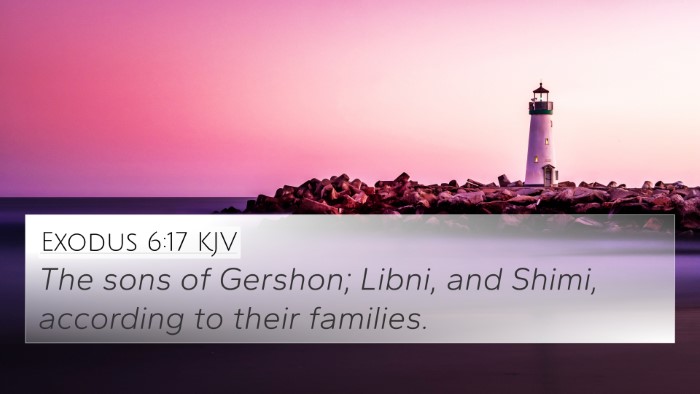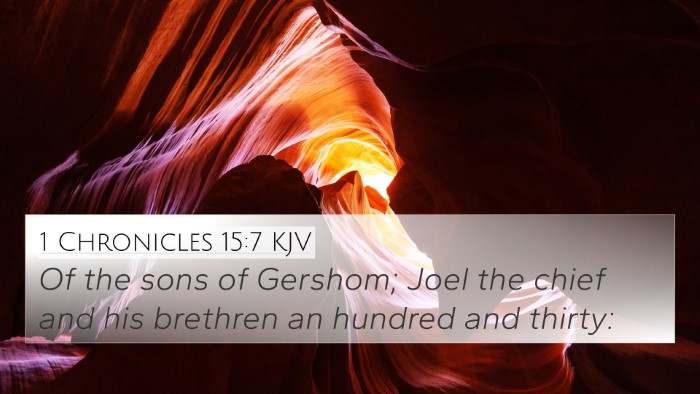Understanding 1 Chronicles 23:7
Verse: 1 Chronicles 23:7 - "Of the sons of Gershom, Laadan and his sons; and Shimei."
Overview: This verse introduces the descendants of Gershom, notably highlighting Laadan and Shimei, who are part of the Levitical priesthood. The context is significant as it outlines the division and organization of the Levites who served in the temple.
Meaning and Interpretations
1 Chronicles 23:7 serves as part of a broader genealogical record that plays a crucial role in demonstrating the importance of the Levitical lineage and their responsibilities within the worship of God.
Genealogical Significance
This verse sets the stage for understanding the Levitical priests, whose roles were pivotal in the Israelite community. According to Matthew Henry, the genealogies documented in Chronicles underscore God's faithfulness to His promises and the rightful lineage that became teachers and singers in the temple.
Roles of Laadan and Shimei
As noted by Albert Barnes, Laadan and Shimei were not just names; they represented a line of service and connection to worship activities that were essential for the spiritual well-being of Israel. Their roles in the temple service imply a foundation built upon order and appropriate worship, essential in the eyes of God.
The Levitical Lineage
Adam Clarke emphasizes the importance of recognizing these specific names as they trace the Levitical lineage. The adherence to the priestly duties and adherence to the laws concerning worship are often cross-referenced in other scriptures, linking this lineage to both Old and New Testament teachings.
Cross-References
- Exodus 6:16-20: Provides the genealogy of the Levites, establishing the lineage back to Levi, further connecting to the responsibilities of the Levitical priests.
- Numbers 3:17-20: Discusses the sons of Levi and their respective roles and duties, giving further context to the family groups within the Levites.
- 1 Chronicles 6:1-15: Further elaborates on the genealogy of the Levites and their roles, establishing the connection between the descendants and the temple service.
- 2 Chronicles 29:12-15: Describes the restoration of temple worship, highlighting the ongoing importance of the Levitical line in worship practices.
- Hebrews 7:14: References the priestly lineage of Jesus Christ and connects it back to the Levitical line, underscoring the ongoing significance of these verses.
- 1 Peter 2:9: While referring to the New Testament believers as a "royal priesthood," it echoes the established roles of the Levitical priests, bridging the themes from the Old Testament.
- Psalm 135:19-21: Highlights the ongoing worship themes relevant to the priests of Israel, reinforcing the legacy of the Levitical line in spiritual activities.
- Malachi 2:4-7: Addresses the priesthood's role in teaching and maintaining order in worship, linking back to the responsibilities outlined in the genealogies.
Connecting Themes
1 Chronicles 23:7 not only highlights genealogical data but is rich with connecting themes regarding worship, service, and faithfulness to God. The roles assigned to Laadan and Shimei serve as important reminders of God's order in worship.
In studying this verse, it is crucial to use tools for Bible cross-referencing. Utilizing a Bible concordance can aid in exploring these connections further and enhancing understanding of scripture's contextual relevance.
Practical Application
For those preparing sermons or engaging in Bible study, understanding these genealogies can enhance the interpretation of God's covenant and His design for worship. By identifying connections between Old and New Testament teachings, one gains deeper insights into God's overarching plan for His people.
Conclusion
1 Chronicles 23:7 provides valuable insights into the establishment and significance of Levitical roles within the temple worship. By recognizing the connections between Bible verses and utilizing cross-reference techniques, believers can enrich their understanding of scripture.
In summary, while 1 Chronicles 23:7 might seem like a simple listing of names, it has profound implications for understanding the organization of worship in ancient Israel. This passage invites further exploration of God’s covenant and His enduring faithfulness through the ages.






